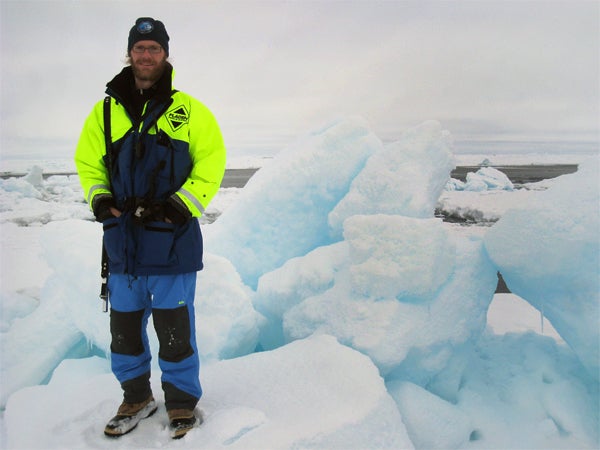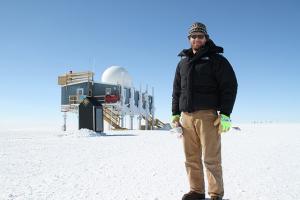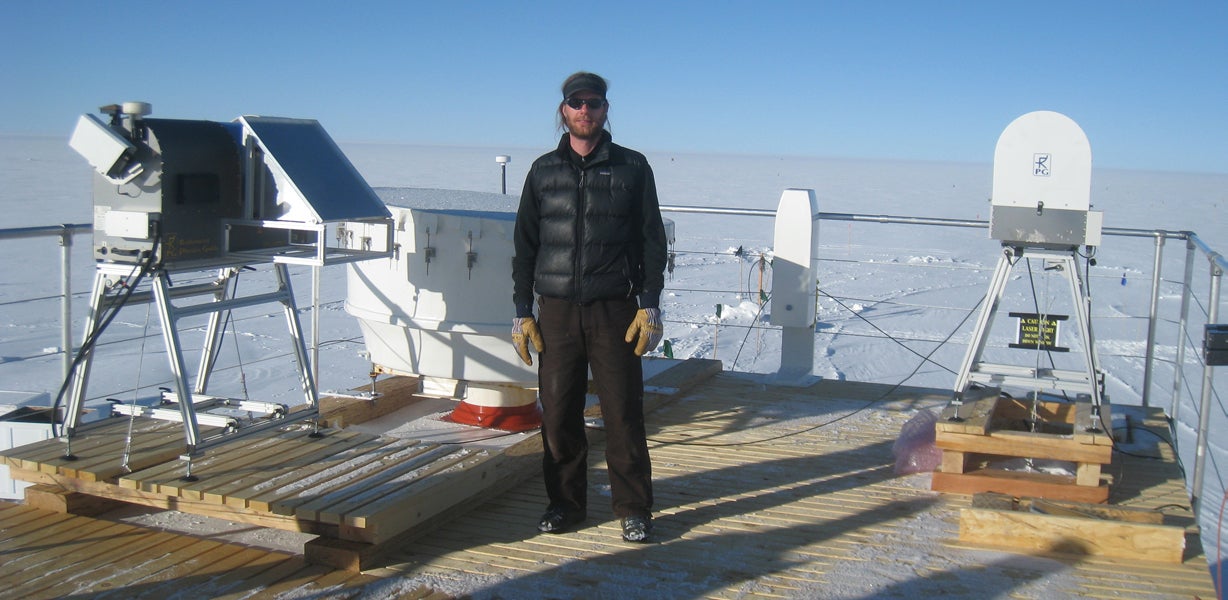Five questions for Matthew Shupe
The “job” that kicked off Matthew Shupe’s career is unforgettable, and so are some of the experiences he has had since, including one that was “straight out of National Geographic.”
Shupe is a research scientist with the Cooperative Institute for Research in Environmental Sciences (CIRES) at CU Boulder and NOAA Earth System Research Laboratory (ESRL) whose focus is Arctic cloud and atmospheric processes.
His goal is to understand the changing Arctic climate system, and in particular, the role clouds, atmospheric structure and surface energy exchange play in those changes, including the melting of sea ice and ice sheets. Using data collected from land, atop ice sheets and the ocean, Shupe is providing the physical understanding required to improve the models used to represent the climate system and forecast its future.
A favorite project was his first, the Surface Heat Budget of the Arctic Ocean (SHEBA) Program in the Beaufort Sea, just north of Alaska, in the late ’90s. He had just graduated with a bachelor’s degree in chemistry/math and was there to gather data using an instrument he helped build.

“It was groundbreaking for my career, in terms of meeting people. I didn’t realize it at the time but there were so many distinguished scientists there. I was eating in the mess hall with them, having social interactions with them,” he said. It was only later that he found out the individuals’ stature in the field; the connections he formed then have been important ever since. The trip was eye-opening in other ways, too. He was part of the project in the middle of winter for six weeks. “I saw the sun in Anchorage when I flew out to the ship,” and he didn’t see it again until he flew back to Alaska.
In 2014, while on an icebreaker moving through the Arctic Ocean, he witnessed some amazing and memorable scenes. “We sailed from Norway to Alaska in late summer. The sun was going down to the horizon for the first time during our seven-week cruise and a full moon was rising on the other horizon. On one side the sky was brilliant sunset orange, and on the other side, a full moon glowed against a deep purple sky. It was glorious.
“Spin the clock forward 12 hours and the sun was high in the sky as we approached the edge of the sea ice. I spied a couple of polar bears and a pile of walrus. The next thing you know, there were more and more everywhere, and there were polar bears eating walrus on red-stained ice floes. It was like National Geographic all around us. I am fortunate to have those experiences because I am out there doing field research that takes me to these extreme and far locations.”
He also is co-lead of the NOAA Physical Science Division’s Polar Observations and Processes research team, a working group chair for the Department of Energy Atmospheric System Research Program, and sits on the United States Study of Environmental Arctic Change (SEARCH) Observing Change Panel.
Even at home, Shupe is never far from the outdoor life, where he enjoys mountain biking and skiing, especially with his wife and two sons, ages 9 and 15. “They are really coming into their own both biking and skiing. It’s exhilarating to move through the woods with your children and see them excel and learn all these skills. Frankly for me, it’s about trying to stay ahead as long as I can.”
1. How did you come to be at the University of Colorado?
It was during my time in the field with the SHEBA project that I met people from NOAA and they basically offered me a job in Boulder. Eventually, it became clear that I probably couldn’t get by for the rest of my scientific career with a bachelor of science degree, so I took classes at CU. At the time, I wrote some grant proposals and got funded with a bachelor’s degree. It wasn’t until after the fact that I learned that people without a Ph.D. are not supposed to submit proposals. That grant funding supported my Ph.D. research, which is not very common.
2. How did you choose this career?
I can’t say that I had this strong desire to be a cloud scientist; it just kind of happened. As an undergraduate in the chemistry department, my professor was interested in atmospheric radiation. Together we built an instrument that looked at the atmosphere and measured spectral infrared radiation. Since I had put all this effort into building this instrument, I really wanted to take it into the field and take some real measurements. Dick Moritz at the University of Washington said that he would get me and my instrument onto a ship in the Arctic if I would launch weather balloons for him. He got me on the ship, frozen in the sea ice, and it was fascinating. I worked for him for free because I was so interested in getting my instrument in the Arctic.
From that experience, I got a job in Boulder analyzing a lot of that data. We learned some really important things and I’ve been building on that during my whole career, trying to understand clouds – their formation and maintenance and composition – and how they interact with the Arctic climate system. As a result of the SHEBA project, we learned that super-cooled liquid clouds are very important in the Arctic and they are quite common. These clouds are comprised of liquid water but they are at temperatures well below the freezing point. Typically, you think that if water gets below the freezing point, it would freeze, and it does in most places around the world. The difference is that water needs a little particle or some kind of substrate to freeze on, but there are not that many of these particles in the Arctic atmosphere so we get a lot of clouds that are liquid water at cold temperatures. It turns out that these kinds of clouds interact more strongly with atmospheric radiation. They have a much stronger effect on the surface and the energy that reaches the surface. Before these measurements, the community didn’t really appreciate the frequency of the occurrence of those clouds or their implications for the Arctic system. Since then, I’ve looked at those clouds across the Arctic in a variety of locations to really try to understand why the clouds exist and how they persist in time.
Another thing we learned is that the numerical models for predicting the climate and forecasting the weather don’t represent these clouds very well. In general, the models want to freeze that liquid water and turn it into ice and that’s a major shortcoming of the models, leading to incorrect representation of surface energy budgets. We’ve really tried to work with our observations to improve the models and how they represent these kinds of clouds.

3. In early June you spent some time in Greenland for another project. What is the project and what did you do while there?
This project is on top of the Greenland Ice Sheet at Summit Station. We’re on top of about 2 miles of ice; it’s pretty fantastic up there. It’s called the ICECAPS project and the research is similar to what I’ve already described. We’re looking at clouds, the atmosphere’s structure, precipitation and other processes and how they influence the energy budget at the surface of the ice sheet, which is related to melting, and how they influence the mass budget, which is related to precipitation, and how much total mass is being added to the ice sheet. The project has been there since 2010 and we are funded through 2018. The collaboration has been wildly successful, producing first-of-their-kind data sets. Four institutions are working together, and a couple of grad students are writing some fantastic papers. We’ve actually had articles in Nature and the Bulletin of the American Meteorological Society, and in both cases, we got the cover of the journal. We’re learning about the processes in an environment that has a different set of conditions.
It is pretty exciting as far as the personal side, too. We’re at Summit Station, at 10,500 feet high. When I was there, the temperature got down to minus 15 degrees Fahrenheit and I was sleeping in a tent. The sun didn’t set the whole time I was there; it just circled the sky. Those are a few of the challenges we have. Another is that because it snows, we have to dig out our equipment, which gets buried in drifts. We have this building on skis and we had to dig it out and pull it up on the ice again.
I go up when I can every summer, which is when access to the site is available via Air National Guard LC-130 aircraft. I fix equipment, adjust things, clean things, and do all the hands-on stuff.
4. You are a lead in the upcoming MOSAiC (Multidisciplinary drifting Observatory for the Study of Arctic Climate). How is this project the same or different from other projects you’ve worked on and what is your role?

The project aims to observe and study the coupled atmosphere/sea ice/ocean system in the Central Arctic. What’s important is that the research will be conducted over a full year, from October 2019 to October 2020, to understand how these interactions occur in all seasons. Ultimately, the research will improve our ability to represent those processes in a variety of models, including sea ice forecasting models. Everybody is interested in forecasting sea ice because it interacts with day-to-day weather systems, it’s important for commerce and the thought of enhanced shipping in the Arctic, and has implications for regional resource development, communities and ecosystems.
The project will be based on and around the German icebreaker - the Polarstern - that will freeze in and drift with the sea ice for a full year. We will have 90-100 people, about half of which will be ship crew and the other half will be scientists. We’ll have instruments and resources all over the ship and also on the ice, spread out on the scale of 20 to 30 kilometers. We’ll sleep and eat on the ship, that’s our home base, but we will have some day-to-day operations on the sea ice. We’ll put things down through holes in the ice to measure the ocean, we will have towers on the ice to look at the atmosphere, and apply a variety of other approaches to look at snow depth and ice thickness, among many other measurements.
We want to follow the ice because it acts as an integrator in the system, melting or freezing depending on the energy at the surface. We’ll be able to measure the input and output of energy coming from the atmosphere and the ocean, so we’re learning how the rest of the system is influencing the growth and decay of the sea ice. We’d like to stay with the same region of ice over this whole time to really understand how it evolves.
As far as my role, I’m the “Chief Motivator.” I’ve been working hard over the last seven years to bring people together on this: I’m an international coordinator and work alongside a couple of partners in Germany who are serving as the chief coordinators on that side of the Atlantic.
5. The logistics of this type of project must be complicated. How will you pull it off?
It’s a huge logistical operation, so getting the Germans to contribute the Polarstern for 13 months was huge. It’s a $30 million investment that they are making, which is fantastic. We will have to support that vessel with food and fuel and we need to move people back and forth because most people don’t want to stay out there for a full year. So the resupply and crew-change challenges are the biggest difficulty now.
The project might involve the Russians and Swedes and a variety of different nations helping out with different aspects. The Chinese have indicated that they are interested in supporting the project. We’ll install the ship in the Central Arctic Ocean and drift toward the North Pole near eastern Greenland. We’ll be as far away from land as you can get, so it’s a nightmare to deal with the logistics, but that’s what it takes to get this full year in the ice. If you choose another location, you’ll eventually get spit out of the ice or melted out of the ice and we’d prefer that not to happen. We’re going for the more challenging approach and we’ll see if we can pull that off or if we’ll have to modify that a little bit.
FIND OUT MORE
Visit these websites to find out more about Matthew Shupe and a few of his projects.
- Matthew Shupe’s personal work: http://www.esrl.noaa.gov/psd/people/matthew.shupe/
- MOSAiC: http://www.mosaicobservatory.org/
- Greenland ICECAPS project: http://www.esrl.noaa.gov/psd/arctic/observatories/summit/


